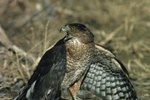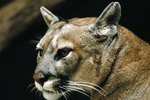
Grasslands -- areas where grasses dominate and water is scarce -- exist throughout the world. North America’s Great Plains, Africa’s savannas, Asia’s steppes, Australia’s rangelands and South America’s pampas, llanos and cerrados are all examples of grassland ecosystems. Grazing and roaming herbivores congregate to feed on the grassland’s abundance of grass and grass-like plants, while carnivorous predators patrol in search of their next meal.
Large Mammals
Grasslands host a myriad of large mammals on five continents. African and Indian elephants, bison, pronghorn antelopes, giraffes, gazelles, buffalos, kangaroos, zebras and rhinos all roam grasslands in search of vegetation. The African elephant (Loxodonta africana) is the largest land animal on Earth. These megaherbivores can easily weigh 6 tons and measure 24 feet long. African elephant herds inhabit grasslands throughout 37 African countries.
Predators
Carnivorous predators inhabit grasslands in high numbers. Jaguars, Sumatran and Malayan tigers, lions, leopards, hyenas, cheetahs, African wild dogs, wolves and coyotes all patrol in search of grazing and roaming prey. However, both the Sumatran tiger (Panthera tigris sumatrae) and the Malayan tiger (Panthera tigris jacksoni) are endangered species. Habitat destruction and poaching have whittled their combined population to less than 900 individuals.
Small Mammals
Grasslands aren’t just an ecosystem for large animals; pint-sized mammals such as rabbits, gophers, prairie dogs, black-footed ferrets, ground squirrels and mice call grasslands home. Black-footed ferrets (Mustela nigripes) came back from the brink of extinction 30 years ago and are the only ferret species native to North America.
Birds
Each of the big three large, flightless birds -- the ostrich, the rhea and the emu -- live in grassland habitats. The ostrich (Struthio camelus) is the world’s largest bird. These powerful, fast runners inhabit the dry savanna grasslands throughout Africa. Birds of prey also make their presence known: hawks, vultures, owls and eagles feed upon smaller mammals and often scavenge a predator’s leftover prey. Small grassland birds such as grouses, meadowlarks, pipits, finches, quails, sparrows and plovers consume an abundance of seeds, berries and insects.
Insects
Insects abound in grasslands. Grasslands habitats encompass bumble bees, crickets, butterflies, locusts, grasshoppers and beetles. Prairie mole crickets (Gryllotalpa major) are the largest mole crickets in North America and can grow up to 2 inches long. These rare, nocturnal crickets spend the majority of their lives burrowing underground in tallgrass prairies.
References
Photo Credits
-
Photos.com/Photos.com/Getty Images
Writer Bio
Christina Stephens is a writer from Portland, Ore. whose main areas of focus are pets and animals, travel and literature. A veterinary assistant, she taught English in South Korea and holds a BA in English with cum laude honors from Portland State University.




